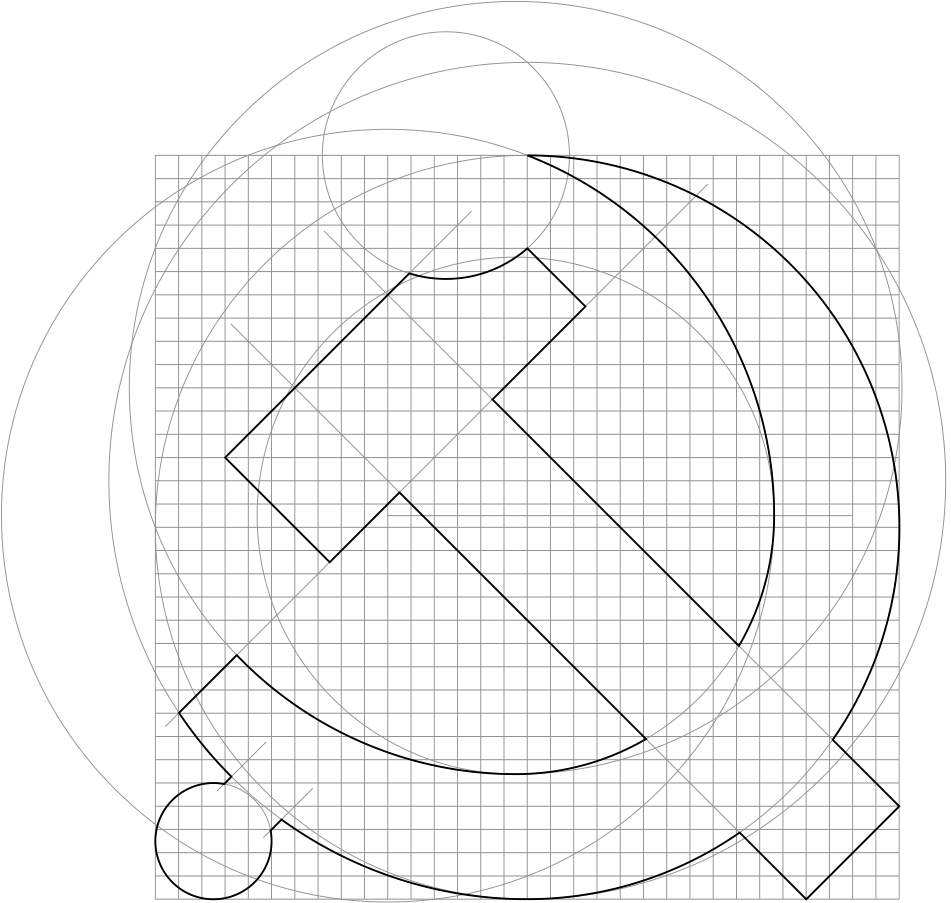\documentclass{standalone}
\usepackage{tikz}
\usetikzlibrary{intersections}
\begin{document}
\begin{tikzpicture}[scale=0.6]
\draw[gray] (1,-1) grid (33,-33);
\path[draw,gray,name path=EF] (29,-33) -- (33,-29);
\path[draw,gray,name path=ER] (29,-33) -- ++ (135:35);
\path[draw,gray,name path=FV] (33,-29) -- ++ (135:35);
\path[draw,gray,name path=GH] (8.5,-18.5) ++ (45:-10) -- ++ (45:33);
\path[draw,gray,name path=GI] (8.5,-18.5) -- (4,-14);
\path[draw,gray,name path=HJ] (19.5,-7.5) -- (17,-5);
\path[draw,gray,name path=IL] (4,-14) -- ++ (45:15);
\path[draw,gray,name path=KJL] (13.5,-1) circle (5.315);
\path[draw,gray,name path=NO] (17,-17) circle (16);
\path[draw,gray,name path=OQ] (17,-15) circle (18);
\path[draw,gray,name path=NS] (11,-16.5) circle (16.62077);
\path[draw,gray,name path=TS] (11,-16.5) -- ++ (20,0);
\path[draw,gray,name path=SU] (16.5,-16.5) circle (11.12077);
\path[draw,gray,name path=UW] (16.5,-11) circle (16.62077);
\path[draw,gray,name path=XYZ] (3.5,-30.5) circle (2.5);
\path[draw,gray,name path=YY] (6,-30) ++ (45:-0.5) -- ++ (45:3);
\path[draw,gray,name path=ZZ] (4,-28) ++ (45:-0.5) -- ++ (45:3);
\path[name intersections={of=EF and ER, by=E}];
\path[name intersections={of=EF and FV, by=F}];
\path[name intersections={of=NO and FV, by=F1}];
\path[name intersections={of=GH and UW, by=W}];
\path[name intersections={of=GH and OQ, by=Q}];
\path[name intersections={of=ZZ and OQ, by=Z1}];
\path[name intersections={of=ZZ and XYZ, by=Z}];
\path[name intersections={of=YY and XYZ, by=Y}];
\path[name intersections={of=YY and OQ, by=Y1}];
\path[name intersections={of=NO and ER, by=E1}];
\path[name intersections={of=SU and FV, name=F2}];
\path[name intersections={of=GH and FV, by=V}];
\path[name intersections={of=GH and HJ, by=H}];
\path[name intersections={of=KJL and HJ, by=J}];
\path[name intersections={of=KJL and IL, by=L}];
\path[name intersections={of=GI and IL, by=I}];
\path[name intersections={of=GI and GH, by=G}];
\path[name intersections={of=ER and GH, by=R}];
\path[name intersections={of=ER and SU, name=E2}];
\draw (E) -- (F) -- (F1) arc (-34.841:90:16) -- (17,-1) arc (68.838715:0:16.62077) -- (27.62077,-16.5) arc (0:-30.262:11.12077) -- (V) -- (H) -- (J) arc (-48.814:-107.27:5.315) -- (L) -- (I) -- (G) -- (R) -- (E2-2) arc (-59.78:-90:11.12077) -- (16.5,-27.62077) arc (-90:-136.18:16.62077) -- (W) -- (Q) arc (-146.26:-134.94:18) -- (Z1) -- (Z) arc (-280.6:10.485:2.5) -- (Y) -- (Y1) arc (-125.93:-90:18) -- (17,-33) arc (-90:-55.183:16) -- (E1) -- cycle;
\end{tikzpicture}
\end{document}
|


